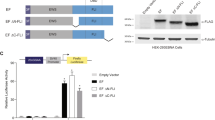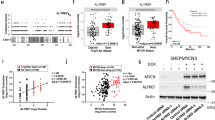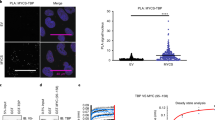Abstract
The maf oncogene of the avian oncogenic retrovirus AS42 encodes a nuclear bZip protein, v-Maf, that recognizes sequences related to the AP-1 target site. The corresponding cellular protein, c-Maf belongs to a family of related bZip proteins together with MafA and MafB. In this paper, we compare the transactivation and cell transforming abilities of MafA and MafB along with two forms of the c-Maf protein. These proteins induce cellular transformation when expressed in chicken embryo fibroblasts. In reporter assays, MafA is a much less effective transactivator than the other Maf proteins, but unexpectedly shows the strongest activity in cell transformation. Chimeras of MafA and MafB correlate the strong cell transforming ability of MafA with its DNA-binding domain. The DNA-binding domain of MafA is also correlated with weak transactivation. Additional mutagenesis experiments show that transactivation and transformation by MafA are also controlled by phosphorylation of two conserved serine residues in the transactivation domain. Finally, we constructed MafA-estrogen receptor fusion molecules that show tightly hormone-dependent cell transforming ability. These regulatable constructs permit a kinetic characterization of target gene responses and facilitate discrimination between direct and indirect targets.
This is a preview of subscription content, access via your institution
Access options
Subscribe to this journal
Receive 50 print issues and online access
$259.00 per year
only $5.18 per issue
Buy this article
- Purchase on Springer Link
- Instant access to full article PDF
Prices may be subject to local taxes which are calculated during checkout








Similar content being viewed by others
References
Andrews NC, Kotkow KJ, Ney PA, Erdjument-Bromage H, Tempst P and Orkin SH . (1993). Proc. Natl. Acad. Sci. USA, 90, 11488–11492.
Benkhelifa S, Provot S, Lecoq O, Pouponnot C, Calothy G and Felder-Schmittbuhl MP . (1998). Oncogene, 17, 247–254.
Benkhelifa S, Provot S, Nabais E, Eychene A, Calothy G and Felder-Schmittbuhl MP . (2001). Mol. Cell. Biol., 21, 4441–4452.
Bergsagel PL and Kuehl WM . (2001). Oncogene, 20, 5611–5622.
Bos TJ, Monteclaro FS, Mitsunobu F, Ball Jr AR, Chang CH, Nishimura T and Vogt PK . (1990). Genes Dev., 4, 1677–1687.
Chesi M, Bergsagel PL, Shonukan OO, Martelli ML, Brents LA, Chen T, Schrock E, Ried T and Kuehl WM . (1998). Blood, 91, 4457–4463.
Cordes SP and Barsh GS . (1994). Cell, 79, 1025–1034.
Fujiwara KT, Kataoka K and Nishizawa M . (1993). Oncogene, 8, 2371–2380.
Hanamura I, Iida S, Akano Y, Hayami Y, Kato M, Miura K, Harada S, Banno S, Wakita A, Kiyoi H, Naoe T, Shimizu S, Sonta SI, Nitta M, Taniwaki M and Ueda R . (2001). Jpn. J. Cancer Res., 92, 638–644.
Ho IC and Glimcher HC . (2002). Cell, 109(Suppl), S109–S120.
Ho IC, Lo D and Glimcher HC . (1998). J. Exp. Med., 188, 1859–1866.
Hughes SH, Greenhouse JJ, Petropoulos CJ and Sutrave P . (1987). J. Virol., 61, 3004–3012.
Igarashi K, Kataoka K, Itoh K, Hayashi N, Nishizawa M and Yamamoto M . (1994). Nature, 367, 568–572.
Itoh K, Chiba T, Takahashi S, Ishii T, Igarashi K, Katoh Y, Oyake T, Hayashi N, Satoh K, Hatayama I, Yamamoto M and Nabeshima Y . (1997). Biochem. Biophys. Res. Commun., 236, 313–322.
Kataoka K, Fujiwara KT, Noda M and Nishizawa M . (1994a). Mol. Cell Biol., 14, 7581–7591.
Kataoka K, Igarashi K, Itoh K, Fujiwara KT, Noda M, Yamamoto M and Nishizawa M . (1995). Mol. Cell. Biol., 15, 2180–2190.
Kataoka K, Nishizawa M and Kawai S . (1993). J. Virol., 67, 2133–2141.
Kataoka K, Noda M and Nishizawa M . (1994b). Mol. Cell. Biol., 14, 700–712.
Kataoka K, Shioda S, Yoshitomo-Nakagawa K, Handa H and Nishizawa M . (2001). J. Biol. Chem., 276, 36849–36856.
Kawai S, Goto N, Kataoka K, Saegusa T, Shinno-Kohno H and Nishizawa M . (1992). Virology, 88, 778–784.
Kawai S and Nishizawa M . (1984). Mol. Cell. Biol., 4, 1172–1174.
Kawauchi S, Takahashi S, Nakajima O, Ogino H, Morita M, Nishizawa M, Yasuda K and Yamamoto M . (1999). J. Biol. Chem., 274, 19254–19260.
Kerppola TK and Curran T . (1994). Oncogene, 9, 675–684.
Kim JI, Ho IC, Grusby MJ and Glimcher LH . (1999a). Immunity, 10, 745–751.
Kim JI, Li T, Ho IC, Grusby MJ and Glimcher LH . (1999b). Proc. Natl. Acad. Sci. USA, 96, 3781–3785.
Kruse U, Iacovoni JS, Goller ME and Vogt PK . (1997). Proc. Natl. Acad. Sci., 94, 12396–12400.
Kumar R, Chen S, Scheurer D, Wang QL, Duh E, Sung CH, Rehemtulla A, Swaroop A, Adler R and Zack DJ . (1996). J. Biol. Chem., 271, 29612–29618.
Kumar V, Green S, Staub A and Chambon P . (1986). EMBO J., 5, 2231–2236.
Mizushima S and Nagata S . (1990). Nucleic Acids Res., 18, 5322.
Nishizawa M, Fu S-L, Kataoka K and Vogt PK . (2003). Oncogene, in press.
Nishizawa M, Kataoka K, Goto N, Fujiwara KT and Kawai S . (1989). Proc. Natl. Acad. Sci. USA, 86, 7711–7715.
Ogino H and Yasuda K . (1998). Science, 280, 115–118.
Olbrot M, Rud J, Moss LG and Sharma A . (2002). Proc. Natl. Acad. Sci. USA, 99, 6737–6742.
Ring BZ, Cordes SP, Overbeek PA and Barsh GS . (2000). Development, 127, 307–317.
Sebolt-Leopold JS . (2000). Oncogene, 19, 6594–6599.
Sharon-Friling R, Richardson J, Sperbeck S, Lee D, Rauchman M, Maas R, Swaroop A and Wistow G . (1998). Mol. Cell. Biol., 18, 2067–2076.
Swaroop A, Xu JZ, Pawar H, Jackson A, Skolnick C and Agarwal N . (1992). Proc. Natl. Acad. Sci. USA, 89, 266–270.
Vogt PK . (1969). Fundamental Techniques in Virology. Habel K and Salzmann NP (eds). Academic Press: New York, pp. 198–211.
Acknowledgements
This work was supported by National Institutes of Health Research Grants CA42564, CA78230, and CA79616. This is manuscript number 15330-MEM of the Department of Molecular and Experimental Medicine, the Scripps Research Institute.
Author information
Authors and Affiliations
Corresponding author
Rights and permissions
About this article
Cite this article
Nishizawa, M., Kataoka, K. & Vogt, P. MafA has strong cell transforming ability but is a weak transactivator. Oncogene 22, 7882–7890 (2003). https://doi.org/10.1038/sj.onc.1206526
Received:
Revised:
Accepted:
Published:
Issue Date:
DOI: https://doi.org/10.1038/sj.onc.1206526
Keywords
This article is cited by
-
The role and regulation of Maf proteins in cancer
Biomarker Research (2023)
-
MAFb protein confers intrinsic resistance to proteasome inhibitors in multiple myeloma
BMC Cancer (2018)
-
GSK3-mediated MAF phosphorylation in multiple myeloma as a potential therapeutic target
Blood Cancer Journal (2014)
-
Reexpression of oncoprotein MafB in proliferative β-cells and Men1 insulinomas in mouse
Oncogene (2012)
-
A new MAFia in cancer
Nature Reviews Cancer (2008)



